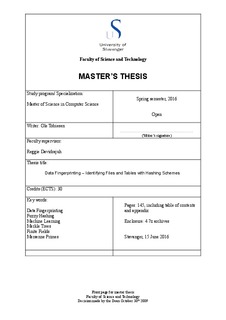| dc.description.abstract | INTRODUCTION: Although hash functions are nothing new, these are not limited
to cryptographic purposes. One important field is data fingerprinting. Here,
the purpose is to generate a digest which serves as a fingerprint (or a license plate)
that uniquely identifies a file. More recently, fuzzy fingerprinting schemes — which
will scrap the avalanche effect in favour of detecting local changes — has hit the
spotlight. The main purpose of this project is to find ways to classify text tables,
and discover where potential changes or inconsitencies have happened.
METHODS: Large parts of this report can be considered applied discrete mathematics
— and finite fields and combinatorics have played an important part. Rabin’s
fingerprinting scheme was tested extensively and compared against existing
cryptographic algorithms, CRC and FNV. Moreover, a self-designed fuzzy hashing
algorithm with the preliminary name No-Frills Hash has been created and tested
against Nilsimsa and Spamsum. NFHash is based on Mersenne primes, and uses a
sliding window to create a fuzzy hash. Futhermore, the usefullness of lookup tables
(with partial seeds) were also explored. The fuzzy hashing algorithm has also been
combined with a k-NN classifier to get an overview over it’s ability to classify files.
In addition to NFHash, Bloom filters combined with Merkle Trees have been the
most important part of this report. This combination will allow a user to see where
a change was made, despite the fact that hash functions are one-way. Large parts of
this project has dealt with the study of other open-source libraries and applications,
such as Cassandra and SSDeep — as well as how bitcoins work. Optimizations have
played a crucial role as well; different approaches to a problem might lead to the
same solution, but resource consumption can be very different.
RESULTS: The results have shown that the Merkle Tree-based approach can track
changes to a table very quickly and efficiently, due to it being conservative when it
comes to CPU resources. Moreover, the self-designed algorithm NFHash also does
well in terms of file classification when it is coupled with a k-NN classifyer.
CONCLUSION: Hash functions refers to a very diverse set of algorithms, and not
just algorithms that serve a limited purpose. Fuzzy Fingerprinting Schemes can still
be considered to be at their infant stage, but a lot has still happened the last ten
years. This project has introduced two new ways to create and compare hashes that
can be compared to similar, yet not necessarily identical files — or to detect if (and
to what extent) a file was changed. Note that the algorithms presented here should
be considered prototypes, and still might need some large scale testing to sort out
potential flaws | nb_NO |

